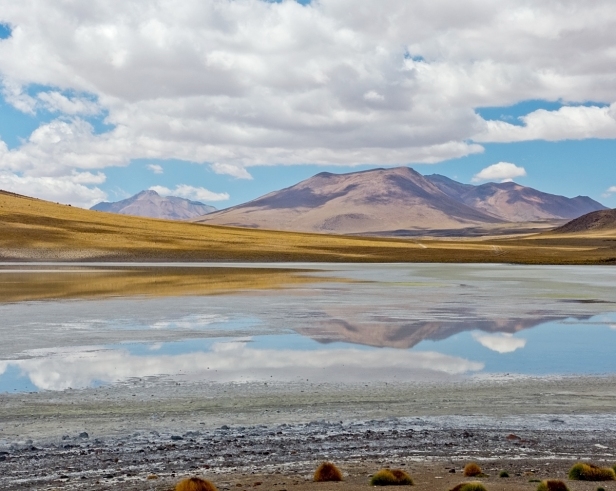
20-21 Dec 2013. We were trip-planning during our stay in Mendoza. We read about a three-day 4×4 overland trip from San Pedro de Atacama, Chile to Uyuni in Bolivia. The more we read the more we wanted to do it, but we were worried about how Don would deal with the altitude. Most people do this journey in reverse, starting in Peru and adjusting to altitudes of 3000 metres or more before heading into Bolivia and facing altitudes of 4000 or more. We would be going from 2400 to 5000 in one day – that’s pretty extreme.
Interestingly enough age has little to do with how well you adjust to altitude; in fact it can even become easier with age. We knew I wouldn’t have any problems with it because last time I was in South America I’d adjusted well and hiked the Inca Trail with no problems. We just didn’t know how Don would do. Some people are just not genetically disposed to adjust. If you want to read a riveting tale about what can happen if you get serious altitude sickness read Danny Breslin’s Me and Gus on the Roof of the World. It seriously affects both mental and physical functioning and it’s a wonder he survived.
We decided to wait until we got to San Pedro de Atacama at 2400 metres to see how well we adjusted before booking any onward travel. We also didn’t want to do the backpackers’ tour, partly because when travelling with a larger group of people you can’t stop just whenever you want to; things are more regimented. Also because we like our comforts. And mostly because we’d read that although some tours say they carry oxygen, it is often just compressed air, which is useless for relieving the symptoms of altitude sickness.
We talked it back and forth for a few days. Slept on it. Don felt into his resistance and fears. His intuition told him that travelling at altitude, beginning with San Pedro de Atacama and then the trip through the High Desert of Bolivia, would be about courage, about being closer to spirit, about pushing beyond fears, above all about attitude, not altitude.
Then Don found a “luxury” tour for a price that made us gasp. Literally. We couldn’t conceive how a three-day tour could possibly cost so much. Then he found another one at half that price. We were hooked. We completely forgot that we were going to wait until San Pedro to see how we adjusted. Because paying by credit card is complicated and antiquated in Bolivia we even sent copies of our passports and credit card front and back by email to effect payment – something we would normally never do. We stepped way out of our monetary comfort zone. It was one of those times where the message was loud and clear – just do it. Two things allayed our fears; they carried oxygen, and we felt confident it would actually be oxygen, not just compressed air, and they also carried a radiophone so if there was a real emergency they could radio for help. The first two days of the tour would be through one of the most remote parts of the world. Forget about cell phones. Forget about roads even.
It was worth every penny. Those three days were one of the great highlights of our tour through South America, and I believe will remain so no matter where we go from here on.
We were collected from our San Pedro hotel early on the first morning and within less than one hour arrived at the border into Bolivia.
This is the Customs and Immigration Office at the border: a lone building in the largely uninhabited Bolivian High Desert.
This is the bathroom at the border – go hide behind the old bus. Everyone else does.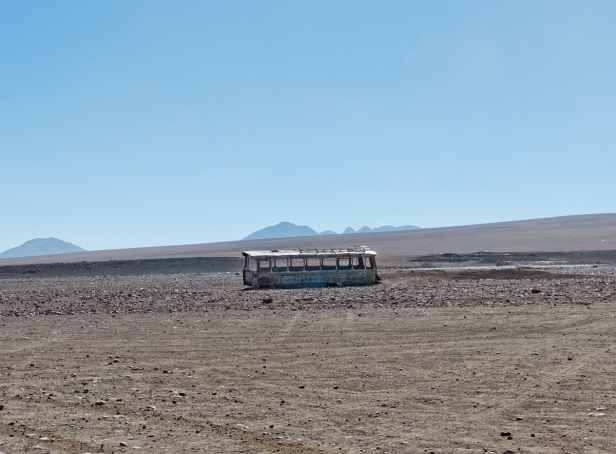
We were met at the border by Juan, our English-speaking guide, and Wilson, our driver. Yes Wilson. Apparently it’s quite a common name for boys in Bolivia. At one point we all had a laugh about Wilson the volleyball in the movie Cast Away. We loaded our gear and set off across country.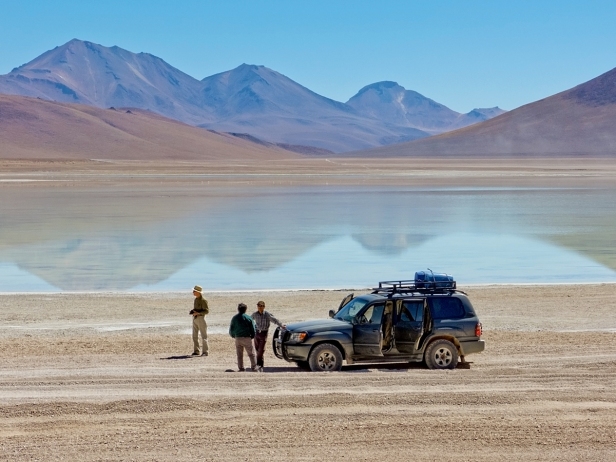
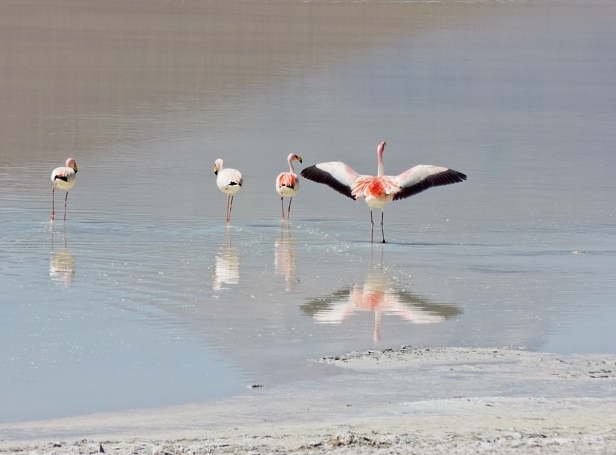
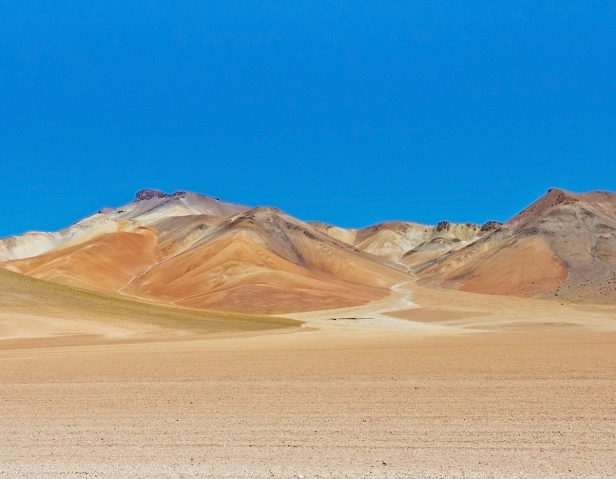
Our first long stop of the day was at a natural hot spring. Unlike the natural hot spring at Geysers del Tatio, this was a hot tub worth hanging out in – so we did. Heaven. Hot hot water and an exquisite etherial view.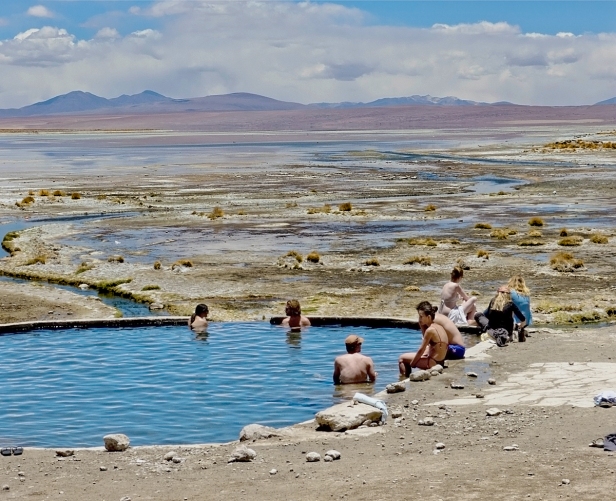
At some point during the day we stopped by one of the many beautiful lagoons and Juan and Wilson, by magic it seemed, produced from the back of the 4×4 some stools to sit on, and on the tail gate proceeded to prepare for us a delicious lunch.
There is a huge geothermal field at high altitude in Bolivia just across the border from the geysers in Chile. It’s a very restless part of the earth that also includes 150 active volcanoes on the Chilean side. At Sol de Mañana (morning sun) the earth is alive, steaming and bubbling. It’s an enormous field of sulfurous boiling mud.
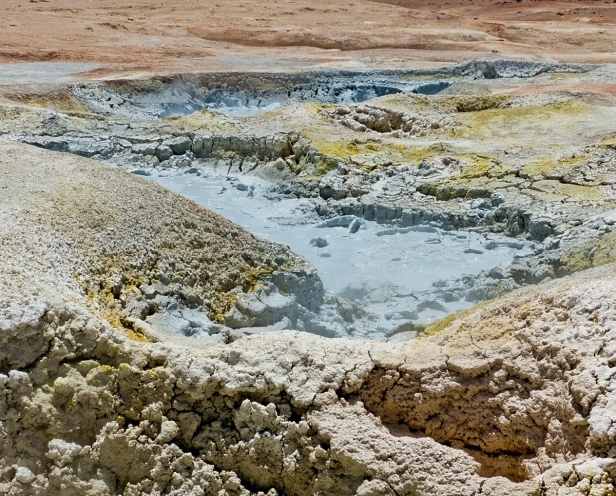
The steam gushes out at 200 degrees centigrade and at 120 kilometers per hour: a small example of earth’s roiling core.
And here we are at the highest point of our journey – 5000 metres or 16,500 feet – not much lower than the Everest base camps.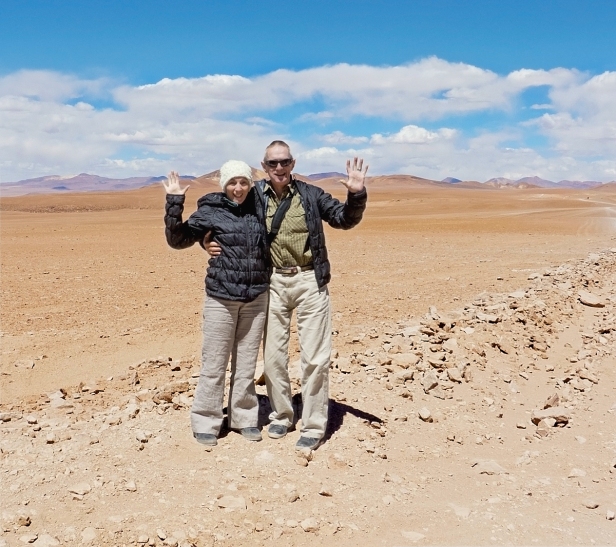
Sometimes the “road” looked like this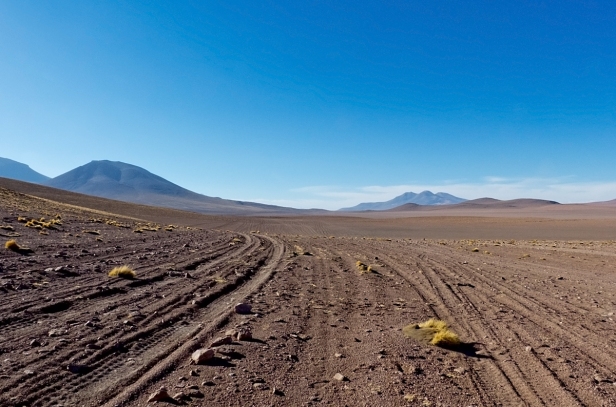
Sometimes it looked like this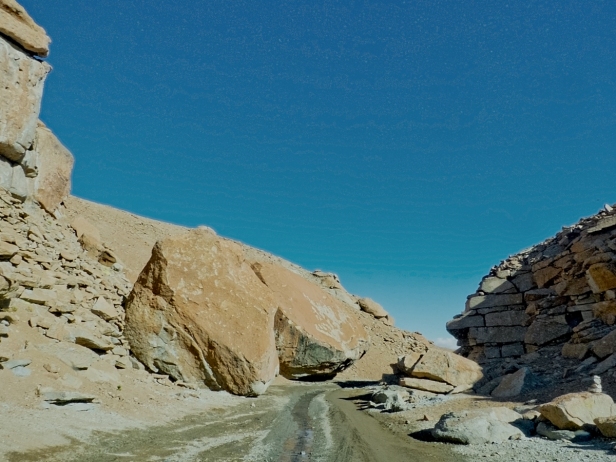
There were flamingoes in every lagoon we came to. Except one. Juan told us about it and why there were no flamingoes there – probably no algae in that particular lagoon, but I don’t remember. This lagoon is red because of the red algae and it is the reason for the colour of the pink-and-red flamingoes. If you eat enough carrots your skin will turn orange. Really. I guess the flamingoes of South America eat a lot of red algae.
Every time we saw wildlife we stopped to look, to take in the magic of our surroundings, and of course to photograph. These are vicuña, a little smaller than the guanacos of Patagonia. Guanacos and llamas are both of the lama genus though different species. Vicuñas and alpacas are both of the vicugna genus. All are related to camels. Guanacos and vicuñas are wild because they cannot be domesticated. Apparently they become very depressed when penned. Llamas and alpacas are completely domesticated. We saw quite a few llamas on our journey, loose and foraging. All had tags on their ears.
Towards the end of the day we came to a surprising collection of strange and elegant rock formations, standing surrounded by the flat desert sand. This is the most iconic, and unusual.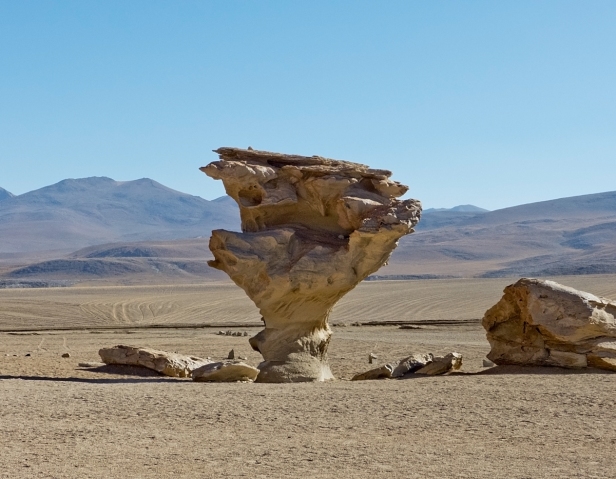
People were climbing them. It looked like fun. I wanted to climb too. Juan was clearly worried about this idea. In the end common sense won for three reasons – the strong wind, I’d never tested the boots I was wearing for grip, and I didn’t know how much stamina I really had at that altitude. I’d been fine all day, getting out of the car at every stop, no dizziness or headaches or nausea. I didn’t try actually running, but for walking around I was fine. For Don it was a little more difficult. He took some oxygen at one point, and was generally a little slower and sat more than wandering around, but was still able to take in all we were experiencing even if he did feel a little spacey.
That first day Don chewed great wads of coca leaves all day, under instructions from Juan, with the small piece of alkali wrapped in the middle to give maximum effect. He also took headache meds. By the second day we were both doing better, feeling more aware and alert as we travelled along. The four of us got on extremely well. Juan was a fountain of information and all round good guy, and Wilson seemed joyful and openhearted and was an excellent driver. Lots of conversation, about them, about us, about Bolivia. Juan would translate for Wilson so he was included. Don and I would both also sometimes talk in our tourist Spanish. We all laughed quite a lot. At the end of the first day we said “Best day ever!”
This was our hotel for the first night. It exists solely because there is a natural spring nearby. It runs on a combination of a generator and solar panels. It is at 4500 metres, and is one of the most isolated hotels in the world. There is nothing else there. Miles and miles of high desert, and this hotel. Don asked for the oxygen cylinder to be put in our room for the night. We both felt safer that way.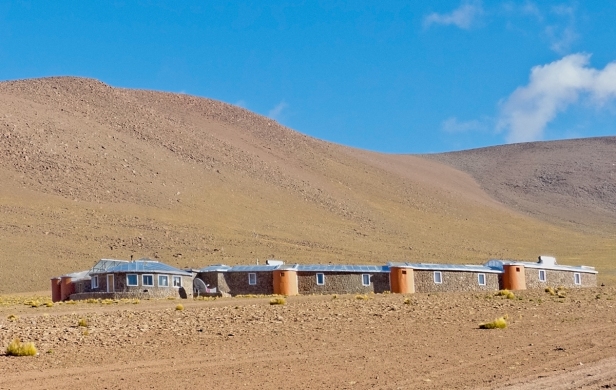
Vizcachas! The next day, driving through a rocky part of the desert we saw vizcachas; and they just hung around for us to look at them and take photos. I think a tourist came up with the word squabbit – a cross between a squirrel and a rabbit, but I like the real name better. We’d seen one before, on the day we went to the geysers in Chile, but it was nestled in between some rocks. Since we couldn’t see its tail it just looked like a brown rabbit, so it was great to see one out in the open. They are closely related to chinchillas, and although unable to rival capybaras they also are rodents of unusual size.
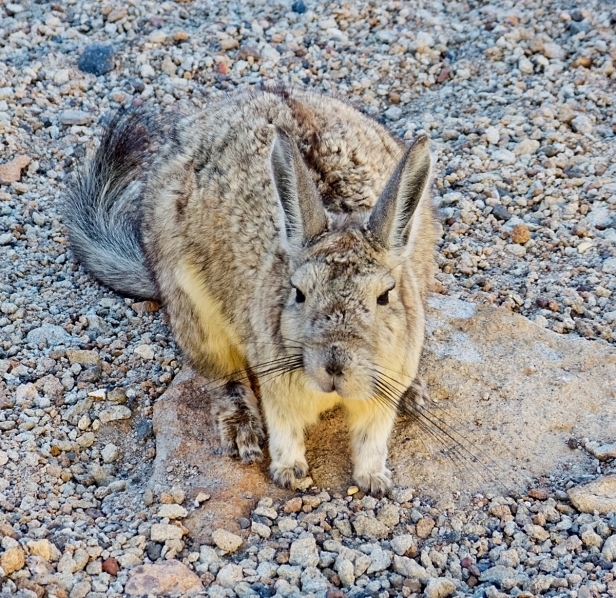
And then we came to the best flamingo lagoon ever. We could sit on the shore right up close and watch them, hundreds of them, doing their elegant flamingo thing. We sat there for a very long time.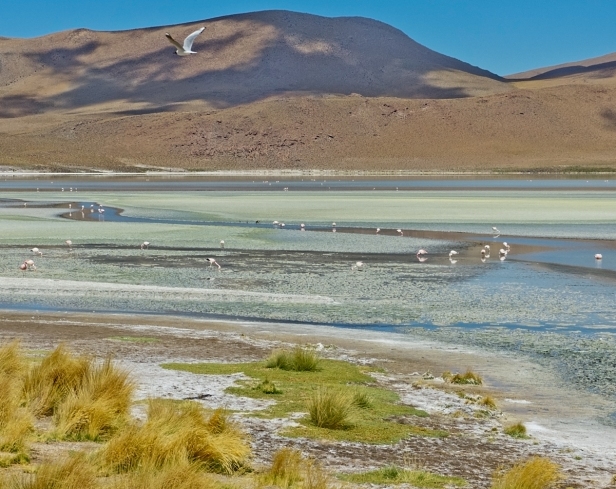

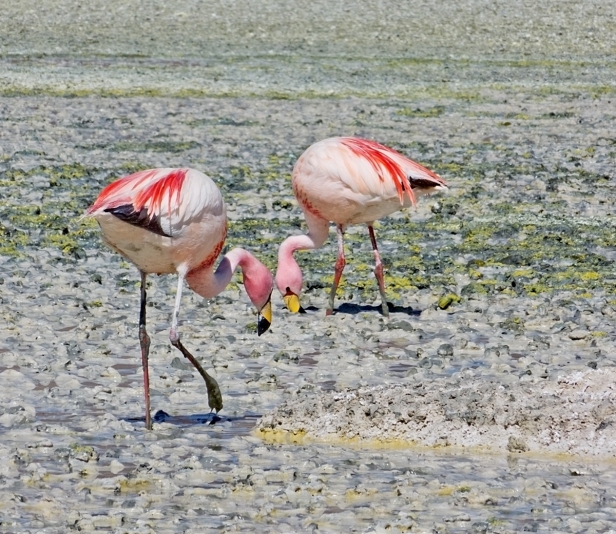
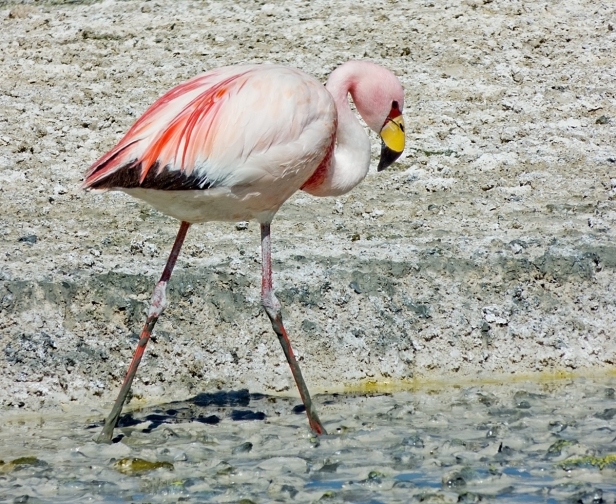
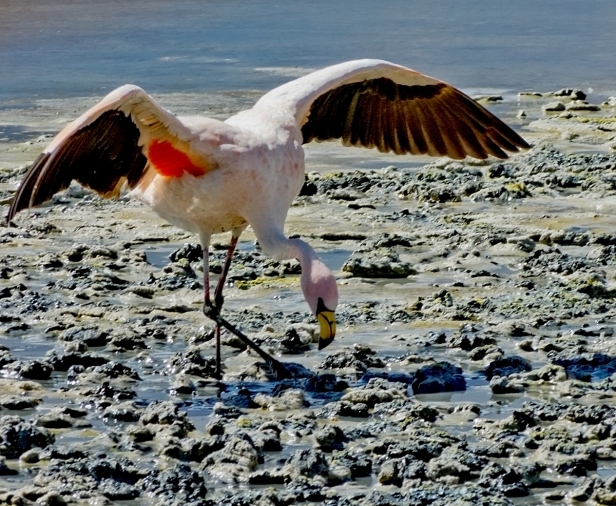
I sang a lot as we travelled! I sang along with the music Wilson had playing. It was on his MP3 player but seemed to be on a continuous loop. I don’t know where the music came from. In Uyuni we heard the same songs in restaurants, and again in Copacabana. All over Bolivia it seems they were playing the music of our youth. It was all music from the 60’s, 70’s and 80’s. The first ever Beatles’ songs – I was only 14 when they came out and I still remembered all the words. The Beatles, Roberta Flack (I’m about 23 by now), Dire Straits (now I’m late 20’s), Sting, Simon and Garfunkel, Tracy Chapman (into my 30’s now), Whitney Houston and much more. So much fun as we travelled through the ever-changing landscape.
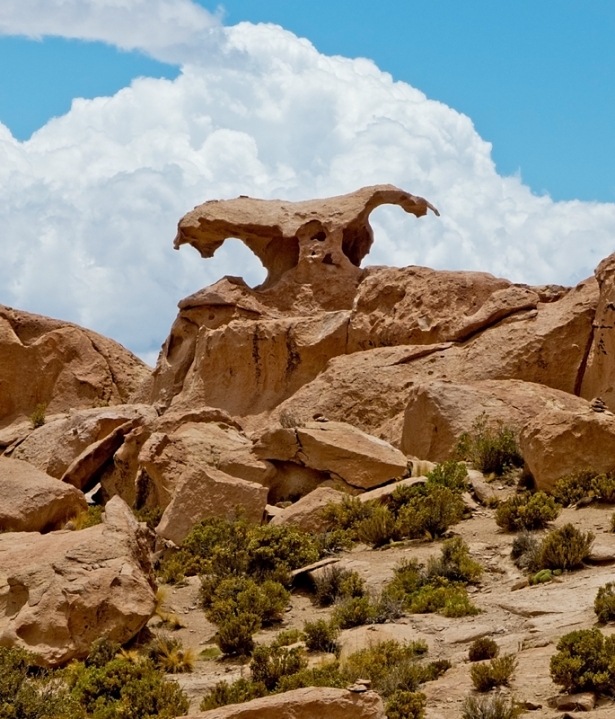
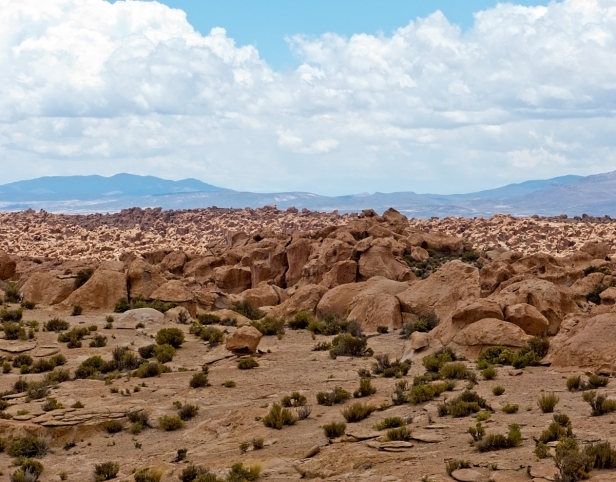
We ended the day at the famous train graveyard. Railways were built between 1888 and 1892 and mainly used by the mining companies. With the collapse of the mining industry in the 1940’s the trains were abandoned, and there they sit to this day. I loved the trains, but was first captivated by the kids playing there. I learned all their names, and that they live nearby in Uyuni. At first they were shy, but soon started playing hide and seek amongst the trains as I photographed them. I so love being able to speak even just a little of the local language so I can ask what is your name and where do you live to break the ice.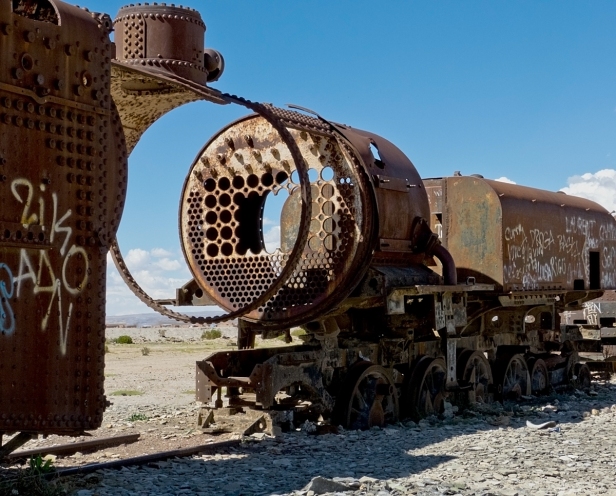

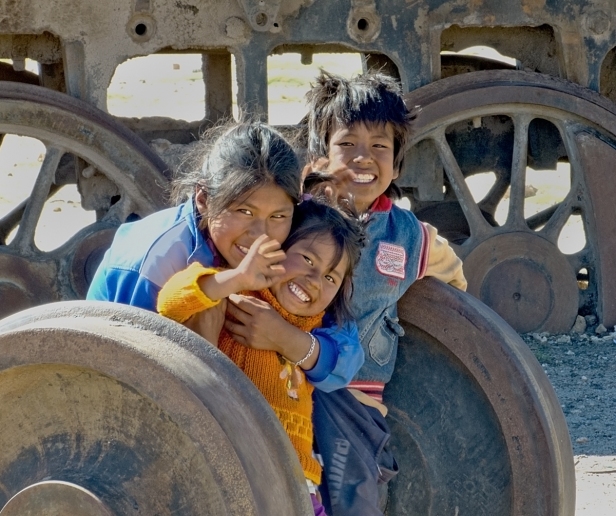

At the end of the day our cry was, yet again, “Best day ever!”
Next post: That night we stayed at a luxury hotel situated at the edge of the great Salar de Uyuni, one of the largest salt flats in the world. The hotel is made of salt. Yes, bricks made of salt. We spent the next day on the salt flats. UnBoliviable!
In the interests of full disclosure I wish I could claim that I had come up with the word unBoliviable, but I first heard it from Juan. It turns out that the word was coined by Frederic Savariau. He first used and published it in a magazine called The Lama Express on the cover of the October 2005 issue with the title: Trekking the UNBOLIVIABLE !!! He also used it at the same time on the front page of a tourism web site called bolivia-guide.com.
You can book this tour at Ruta Verde Tours. We highly recommend it, and we have not been paid to say so.

All words and images by Alison Louise Armstrong unless otherwise noted.
© Alison Louise Armstrong and Adventures in Wonderland – a pilgrimage of the heart, 2010-2015.

look at you two go! 🙂
LikeLike
Yep! Found a way to do it and not completely freak ourselves out!
Thanks 🙂
xox
LikeLike
Alison, I like very much your honesty about the origin of the neologism “unBOLIVIAble”
which I fisrt used and published in a monthly magazine called The Llama Express. I first used it for the october 2005 cover issje, picturing the salt flat with the title: Trekking the UNBOLIVIABLE !!! and usedit as the same time on the front page of a tourism web site called bolivia-guide.com
Few people have your honesty an a lot have just grabbed it as their own.
You are a good person
All the best
LikeLiked by 1 person
How lovely to hear from you Frederic! So nice to “meet” the person who created this perfect word for Bolivia. I will edit my post so any future readers know the source of it.
All the best to you too Frederic.
Alison
LikeLike
UnBoliviable indeed! So many things to be impressed with: flamingos, rock sculptures (sort of like hoodoos), beautiful scenery and the huggable vizcachas– at least I wanted to hug one.
Altitude sickness– I dealt with it fairly often when I led hundred mile backpack trips up and down the High Sierra of California, which sometimes included climbing Mt. Whitney. One thing we found helpful was eating anti-acid pills. I learned it from a 70+ year old man who often climbed Mt. Shasta in Northern California. He was known as “the Old Man of the Mountain.” 🙂 –Curt
LikeLike
Yes, lots to be impressed with. It is a really amazing and beautiful part of the world. So very glad we went that way, and found a way to be able to.
That’s interesting about the antacid pills. We were both taking an altitude sickness medication that was giving us a bit of acid stomach so we were eating antacid pills. They probably did more good than the medication! We stopped taking it after a while.
LikeLike
One of the few good things about altitude sickness is it usually goes away if you have time to adjust to the altitude. –Curt
LikeLike
I think we’ve finally adjusted – 3 weeks at about 3400. Thing is we go to sea level for a week (Lima) then back to 3900 for a festival in Puno – we’ve read the adjustment lasts a few weeks so we’re hoping that’s true! 🙂
LikeLike
That it does, Alison. At least it always did for me. And I moved quite often from a few hundred feet back to 12-14 thousand feet. –Curt
LikeLike
Good to know. Thanks.
LikeLike
The vizcachas look like a chimera consisting of a rabbit and a squirrel. Really glad it worked out for Don! The pictures were beautiful, but the presence of people in the landscapes really brought home what beautiful beings we are. The Bolivian family… the little girl… the hot springs… Makes me realize that while some view people as a burden to the planet, there is also so much beauty…
Michael
LikeLike
Thanks Michael. Yes there is so much beauty, in the landscape, and in the people. I loved seeing those kids playing at the train graveyard. The landscape is extraordinarily beautiful, and the wildlife also, but it was wonderful to connect with those kids. There was a lot of joy there. It was a very special time for us travelling through a very special place.
LikeLike
You two are incredible! What a fantastic time this was for you. That little girl is cuteness personified!
LikeLike
Thanks Angeline. Yeah, it really was a great time – being so well taken care of and getting to travel through that amazing landscape mostly at our own pace – we could stop whenever we wanted, and did.
LikeLike
Alison, you got me hooked. It sounds like the further you go into Bolivia the more incredible the sights turn to be. I really love the rock formations, flamingo lakes and of course, the abandoned train with those local children. By the way, staying at that very remote hotel seems very intriguing. I remember in Bond’s Quantum of Solace there’s this scene of similar hotel called ‘Perla de las Dunas’, dramatically set against the Bolivian dessert landscape. I wonder how it feels to stay so far away from everything.
LikeLike
Thanks Bama, glad you enjoyed it. It really is an astonishing landscape. It was even better than we could have thought. My favourite is the flamingoes, and the vicuñas, and the rock formations, and the beauty of the landscape, and the . . . . . and the . . . Everything about it was thrilling.
I haven’t seen Quantum of Solace. Don has but he doesn’t remember the hotel scene. Could be the same place though.
LikeLike
Glad you both survived the altitude to really enjoy this amazing landscape. I love the photos you captured your journey well.
LikeLike
Thanks Chris. Once we figured out a way to do it without scaring ourselves silly it became a really special adventure, made better by the fact that the two guys we were travelling with were such good company. Hard to take bad photos of such incredible scenery, and we were lucky with the weather too!
LikeLike
Another fabulous post, Alison 🙂
The landscape looks so alien and it’s one place to explore in a life time.
Have a great day.
LikeLike
Thanks Sreejith, I’m glad you enjoyed it. It is such an amazing place. Your word is right – alien. And very beautiful. Definitely a once in a lifetime journey.
You too – have a great day!
LikeLike
That’s the sort of adventure I love; big landscapes, remoteness, few people, conversations with locals. Perfecto! It’s an inspiration for the day. Thank you.
LikeLike
Thank you! I’m glad you enjoyed it. Yes, it was absolutely perfecto! Mile after mile of ever-changing gorgeous beauty.
LikeLike
Amazing, extrardinary place! Perfectly titled and presented as always Alison 🙂
LikeLike
Thanks Pelly, glad you liked it. Yes it really in an extraordinary place – we were constantly thrilled by the place, and the adventure of it.
LikeLike
This is a wonderful post! Like many of your posts, I feel as if I were right beside you during the adventure. And all without leaving my living room. 🙂
LikeLike
Thanks Felicity, glad you enjoyed it. Very happy to have you travelling with us 🙂
LikeLike
Alison, you’ve done it again – the photos are sublime and your excitement just bubbles through the words. If the high desert and altiplano look like that on camera, it must be completely mindblowing to be there in person! I’m glad Don seemed to adjust fairly well to the altitude – bravo to him for taking the gamble and pushing beyond his fears. Imagine what you would have missed if you hadn’t gone on this trip! And those vizcachas are just adorable, seems like the ones you saw may have lost their fear of humans… either that or you and Don are great with animals. 🙂
LikeLike
Thank you so much James – I’m glad you could get something of how we were feeling despite the altitude. And yes it is completely mind-blowing in person. We are so glad we found a way to do it and not scare ourselves silly. It was really Don’s heart issues, even though his cardio specialist had told him altitude wouldn’t be a problem. Thing is you never know til you get there. I don’t know about the vizcachas – maybe they’d been fed by other groups going through, or just have never had any reason to fear humans. Too cute eh?
LikeLike
I was wondering if at the Bolivian border they checked to see that you had the yellow fever vaccination? We are going to Bolivia this June for hiking and Spanish. Now we will consider the desert. Thank you
Anita
LikeLike
Hi Anita. We were not asked for proof of the yellow fever vaccination, but this was at a very remote border crossing and basically all they did was stamp our passports. If you fly into La Paz from outside of Bolivia they might be more official about things like that.
Enjoy Bolivia!
Alison
LikeLike
Wow wow wow!!!
LikeLike
It’s a very wow kind of place 🙂
Every day – Best. Day. Evah!!!!
LikeLike
Beautiful and courageous. Love the movie references–Wilson and Rodents of Extraordinary size. You guys are amazing. I know that is starting to sound redundant, but I just don’t want you to forget in the menial times. {{{Hugs}}} Kozo
LikeLike
Thanks Kozo. There came a point when we realized we weren’t going to let fear hold us back, and that we were going to take the risk and do it anyway. The tour we chose helped minimize the risk. And what a reward we received. Best. Tour. Ever! (We love the menial times :))
(((((hugs))))) Alison
LikeLike
Stunning….simply stunning.
LikeLike
Thanks Debbie. It was a magical place, and a very special trip. As you say – stunning. We had no idea it was going to be as extraordinary and beautiful as it was.
LikeLike
Wow, wow, wow! Too many excellent pictures to choose a favorite!
LikeLike
Thanks Kelly. It’s a very wow kind of place, definitely a highlight of South America. Even now when I think about I can hardly believe we had that experience. The third day, which I’ll cover in the next post, was just as wow.
LikeLike
What a trip this one was. I started to feel short of breath just reading this and would have felt more secure with an oxygen canister in the room as well. Amazing, in the middle of nothing. And, the open landscape-stunning. xoxo
LikeLike
Oh it was a thrilling adventure – such beautiful landscape, and the wildlife, and the remoteness. All so much better than we knew, or imagined, it would be. Hope you’ve got your breath back now 🙂
xoxox
LikeLike
Best writing and photos to date. Loved it.
Love you both Suze
LikeLike
Thanks. Hard to go wrong with such beautiful landscape and such excellent adventure!
Love you too
A&D
LikeLike
This is so nice! Hope you can visit my blogsite, read a few articles and follow too 🙂
http://diorruado.wordpress.com/
Continue writing!
LikeLike
Thank you so much. I’ll go have a look around your site.
Cheers
Alison
LikeLike
Magical. That’s all that comes to mind. You have given your followers a gift of enormous dimensions. Thank you! You and Don are the most special people I had the privilege to meet on cyberspace but have never met in person. I would sincerely hope to have the opportunity to do so in the future. Safe travels, dear friends!
LikeLike
Oh Helga thank you so much for your kind words. I’m so happy that you’re enjoying our travels. This trip through Bolivia was indeed magical.
I can’t keep up with all you 5writers! I think you were all based in/near Van but some of you have moved. Are you still there? We will be there for 6 months starting late May so hopefully we could get together in RL at some point. That would be lovely.
LikeLike
What an amazing sounding trip! Thanks for sharing. Who would have thought that there is so much to do in the desert. You opened my eyes! I’ll have to add this area to my travel bucket list 😀
LikeLike
Thanks estadl. It certainly opened our eyes! It was better than we could ever have imagined. I’d recommend anyone to go there. It’s amazing.
LikeLike
This sounds like the adventure of a lifetime! I too have been plagued by altitude sickness so it would be something I would have to seriously consider as well. Loved all your photos but those of the children and the flamingo in the water with its reflection captured were so special. 🙂
LikeLike
Thanks LuAnn. Yes, it definitely was the adventure of a lifetime – really special. I loved being able to sit with and photograph those flamingoes. We were so close to them. And the kids were a lot of fun.
LikeLike
Surreal and breathtaking landscapes! And the flamingo photo in blue water is perfection. Beautiful post!
LikeLike
Thank you so much. The landscape continually amazed and thrilled us. We couldn’t believe we were travelling through such an extraordinary place, and that time with the flamingoes was so special. They were so close.
LikeLike
What great pictures. . You’ve been awarded the Sunshine Award. Just go to my blog anthrode.wordpress.com for the instructions for accepting. Congrats. Vaya con dios, Lucy
LikeLike
Thank you so much Lucy, and thank you for the award! How wonderful. I must warn you though that although I love responding to awards, it does take me a while to get around to it – too busy exploring the world 🙂
Alison
LikeLike
OK, I do believe those “bathroom facilities” behind the bus were exactly the kind I was referring to in an earlier post. (!) Felicity and I discussed that detail as well as the fabulous photography in a recent phone call.
LikeLike
Thanks so much Pam. Yes I remember that post. Well I must say this bus was the most, um, basic, bathroom we’ve encountered so far in South America, though occasionally while hiking we’ve had to find a convenient bush.
So lovely to hear you and Felicity talking about our blog! Delighted!
Alison
LikeLike
Very interesting, those half-rabbit-squirrel animals. I never thought of Bolivia looking like that, landscape-wise.
LikeLike
We sure never thought of Bolivia looking like that either – it was a wonderful surprise, as were the vizcachas. We’d never heard of them before we went to South America. Seeing some was a huge bonus.
LikeLike
It would be the equivalent of us seeing storks in Germany. 🙂
LikeLike
Your photos are exquisite. So barren but beautiful too 🙂 Lakshmi x
LikeLike
Thanks Lakshmi. Yes it’s very beautiful. It was definitely a highlight of South America.
LikeLike
Thanks for the mention. This post made me breathless just reading it. Since the incident in Tibet I’ve even avoided high kerbs.
LikeLike
You’re welcome! I always knew I had to mention your book as part of this post. It’s such a vivid description of altitude sickness.
Glad you enjoyed the post ha ha 🙂
Stay off those kerbs now!
LikeLike
unbeleivable indeed. thank you for sharing this very interesting travel article.
LikeLike
Thanks Francina, and you’re welcome. It’s my pleasure to share it. Our trip through the High Desert of Bolivia was truly a once in a lifetime amazing experience. We were continually surprised and delighted.
LikeLike
Hi Alison and Don. This is simply breathtaking! Thanks for sharing this post and your lovely travels with us.
With Love
Nadine
LikeLike
Thank you so much Nadine. I’m glad you enjoyed it. We certainly did. That trip through Bolivia was one of the great highlights of our travels in South America. Sharing is a great pleasure.
Blessings, Alison
LikeLike
Oh my gosh, thank you for pointing out this post to me – truly magical and enchanted place. How incredible to experience so many “best day ever”s! Your pictures are so wonderful! What a delightful read.
LikeLike
Thanks mithriluna, and you’re welcome – glad you enjoyed it. And you got it exactly – a truly magical and enchanted place. We had no idea it would be so extraordinary.
LikeLike
Thanks for this! I’m currently in Sucre for a few weeks with various other Bolivian destinations in mind (obviously including Uynuni) and your tour recommendation is very helpful. I’ve checked their site and they go to several of the places I want to visit by tour. Excellent. Great photos and I particularly loved the reference to rodents of unusual size. 🙂
LikeLike
Thanks Becca. Glad you enjoyed the post, and that you found it helpful. The tour we did was expensive but we thought it was so worth it. There are lots of other options for travelling through the area we went through – you’ll find them online. We decided to pass on Sucre though by all reports it’s a nice place. Don is a huge fan of The Princess Bride 🙂
LikeLike
Informative article and beautiful photos you have there. This article really helped me to prep up for my journey to Bolivia and Peru next year. Thanks for sharing with us. 🙂
If you need any info on adventures in South East Asia, do peek around my travelogue: eudaimoniacs.com
Okie so I’m going to continue reading the rest of your posts now. Stay beautiful!
LikeLike
Oh my goodness, I am so sorry it has taken so long for me to reply to you! I somehow missed your comment. Thank you so much for your kind words, and I’m glad it was helpful.
We don’t need any info on SE Asia at the moment having spent several months there last year, but I plan on exploring your blog anyway – from a brief glimpse it looks fabulous. Happy travels, Alison
LikeLike
I love your posts they are rich in details, and the photos are very nice. This post for instance is just great. I am form Bolivia but I have not gotten a chance to travel that much. I only know of the places you have visited through books and my dad stories, he once told me about the trains’ graveyard!
LikeLike
Thank you so much Peter. I hope one day you will be able to explore more of your own country. I only saw a small part of it and it is very very beautiful.
LikeLike
Just found your blog via a Google search as we are planning a trip to Bolivia for next April (planning on using frequent flier miles to get there, hence the advance planning). I am so glad I found this blog about your more “upscale” tour. All of the scary stories I’ve been reading about the drunk drivers and hostels have been scaring me a bit. I love the idea of doing this tour but with hotels and modest accommodations. Glad I found your blog and will enjoy reading about your adventures!
LikeLike
We’ve done the ‘plan a year ahead to use points’ thing – it’s the only way to get to use them. Thanks for your kind words about the blog, and I hope you find a tour through Bolivia that suits you. It really is worth it. Ruta Verde was a bit expensive but very good. The hotel the first night was modest I suppose, but mainly because of its remote location. The salt hotel is definitely more up-market. As far as I know accommodations are either the ones we stayed in or backpacker hostels, but you may well discover there are other options in your own research.
Happy travels, Alison
LikeLike
My next destination! Thanks for providing info and your first impressions. Happy travelling.
LikeLike
You’re welcome! Have a great time in this extraordinarily beautiful place.
Alison
LikeLike
What a beautiful post! Your pictures really capture what you experienced! I have had the Salar de Uyuni on my list and cannot wait to see it in person! Do you have any pictures of the salt flats that you could post?
LikeLike
Thanks so much, I’m so glad you enjoyed it. The post called “SaltFlats and Bowler Hats” has pictures of the salt flats. https://alisonanddon.wordpress.com/2014/01/31/salt-flats-and-bowler-hats-uyuni-and-copacabana-bolivia/
Enjoy!
Alison
LikeLike
Oh my goodness, I just love your photos for this piece–the landscape, the wildlife, the kids, all so beautiful! And it looks like this was an amazing experience. I’ve never thought much about visiting Bolivia, but you’ve changed my mind.
LikeLiked by 1 person
Thank you so much Wendy. It was a really extraordinary experience, and way better than we had any idea it would be. Even 7 years later it remains one of the highlights of all our travels. I hope you get there one day. A word of caution – pay the money to go with a reputable tour company. There have been accidents and deaths with the cheap backpacker tours.
Alison
LikeLike
I loved reading this post as it brought back so many wonderful memories of my visit to the area in 2017. The landscapes, lakes, rock formations & animals are so unique to the area, it feels like you are the first to discover it. Thanks for sharing & as always for your wonderful photos.
LikeLiked by 1 person
Thanks so much Sue. I’m glad it brought back good memories for you. It’s such an extraordinary part of the world. This tour remains one of the highlights of all our travels.
Alison
LikeLike
A great read, stunning scenery and beautiful photos as usual. What an adventure, not an easy one to do.
LikeLiked by 1 person
Thanks so much Alma, I’m glad you enjoyed it. It was a really epic trip, but was made comfortable enough by our very good guide and driver who took great care of us.
Alison
LikeLike
Oh what a best day EVER moment. From the landscape to the people (and wildlife) this would be a trip that would forever hang on in your memory.
LikeLiked by 1 person
It was truly awesome! One of the best things we ever did. Everything about it was perfect. I doubt I’ll ever forget it.
Alison
LikeLike
Your three days in Bolivia look amazing. We will need to plan to visit when we finally get back to South America. Good thing you found a better price for the tour. The variety of landscapes and natural colour is stunning. I will be keeping this post for the tour operator info! Linda (LD Holland)
LikeLiked by 1 person
It was really epic Linda. I can’t recommend it enough. I hope you get to do it one day.
Alison
LikeLike
Oh I really enjoyed this post. Your pictures are truly stunning. I have always been intrigued by Bolivia after seeing a “travel show ” on TV. I think it was a “back roads” show. They drove through where you did and yes the road is sometimes a lot not a road. Your post has certainly kept my intrigue going. UnBoliviabel is spot on. Thank you
LikeLiked by 1 person
Thank you so much. I’m glad you enjoyed it. I would think the TV show would show the same place – there really is only one route through the high desert. It’s pretty amazing.
Alison
LikeLiked by 1 person
Wow, thank you for you sharing this. I spent time in San Pedro de Atacama in Chile and was hoping to get over to Bolivia, but obviously Covid changed my plans. I loved your photos and the train graveyard looks so fascinating.It’s such a unique landscape in this region. I absolutely need to get to Bolivia.
LikeLiked by 1 person
Thanks so much Megs. The landscape is quite extraordinary. We didn’t know what to expect but it just kept getting better and better. Too bad your trip got cut short 😦
I hope you get there one day.
Alison
LikeLike